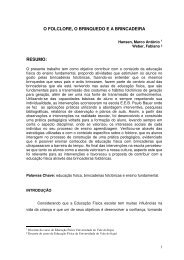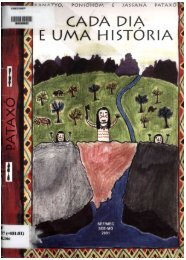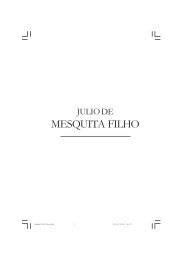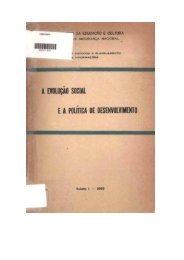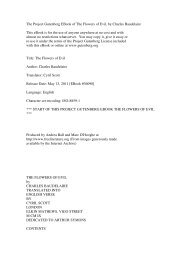A History of English Literature
A History of English Literature
A History of English Literature
You also want an ePaper? Increase the reach of your titles
YUMPU automatically turns print PDFs into web optimized ePapers that Google loves.
Allworthy, intended as an example <strong>of</strong> benevolent perfection, is no less <strong>of</strong> a<br />
pale abstraction than Sir Charles Grandison. The women, cleverly as their<br />
typical feminine traits are brought out, are really viewed only from<br />
without.<br />
THE OTHER SENTIMENTALISTS AND REALISTS. Richardson and Fielding set in<br />
motion two currents, <strong>of</strong> sentimentalism and realism, respectively, which<br />
flowed vigorously in the novel during the next generation, and indeed<br />
(since they are <strong>of</strong> the essence <strong>of</strong> life), have continued, with various<br />
modifications, down to our own time. Of the succeeding realists the most<br />
important is Tobias Smollett, a Scottish ex-physician <strong>of</strong> violent and brutal<br />
nature, who began to produce his picaresque stories <strong>of</strong> adventure during the<br />
lifetime <strong>of</strong> Fielding. He made ferociously unqualified attacks on the<br />
statesmen <strong>of</strong> his day, and in spite <strong>of</strong> much power, the coarseness <strong>of</strong> his<br />
works renders them now almost unreadable. But he performed one definite<br />
service; in 'Roderick Random,' drawing on his early experiences as a ship's<br />
surgeon, he inaugurated the out-and-out sea story, that is the story which<br />
takes place not, like 'Robinson Crusoe,' in small part, but mainly, on<br />
board ship. Prominent, on the other hand, among the sentimentalists is<br />
Laurence Sterne, who, inappropriately enough, was a clergyman, the author<br />
<strong>of</strong> 'Tristram Shandy.' This book is quite unlike anything else ever written.<br />
Sterne published it in nine successive volumes during almost as many years,<br />
and he made a point <strong>of</strong> almost complete formlessness and every sort <strong>of</strong><br />
whimsicality. The hero is not born until the third volume, the story mostly<br />
relates to other people and things, pages are left blank to be filled out<br />
by the reader--no grotesque device or sudden trick can be too fantastic for<br />
Sterne. But he has the gift <strong>of</strong> delicate pathos and humor, and certain<br />
episodes in the book are justly famous, such as the one where Uncle Toby<br />
carefully puts a fly out <strong>of</strong> the window, refusing to 'hurt a hair <strong>of</strong> its<br />
head,' on the ground that 'the world surely is wide enough to hold both<br />
thee and me.' The best <strong>of</strong> all the sentimental stories is Goldsmith's 'Vicar<br />
<strong>of</strong> Wakefield' (1766), <strong>of</strong> which we have already spoken (above, page 244).<br />
With its kindly humor, its single-hearted wholesomeness, and its delightful<br />
figure <strong>of</strong> Dr. Primrose it remains, in spite <strong>of</strong> its artlessness, one <strong>of</strong> the<br />
permanent landmarks <strong>of</strong> <strong>English</strong> fiction.<br />
HISTORICAL AND 'GOTHIC' ROMANCES. Stories which purported to reproduce the<br />
life <strong>of</strong> the Past were not unknown in England in the seventeenth century,<br />
but the real beginning <strong>of</strong> the historical novel and romance belongs to the<br />
later part <strong>of</strong> the eighteenth century. The extravagance <strong>of</strong> romantic writers<br />
at that time, further, created a sort <strong>of</strong> subspecies called in its day and<br />
since the 'Gothic' romance. These 'Gothic' stories are nominally located in<br />
the Middle Ages, but their main object is not to give an accurate picture<br />
<strong>of</strong> medieval life, but to arouse terror in the reader, by means <strong>of</strong> a<br />
fantastic apparatus <strong>of</strong> gloomy castles, somber villains, distressed and<br />
sentimental heroines, and supernatural mystery. The form was inaugurated by<br />
Horace Walpole, the son <strong>of</strong> the former Prime Minister, who built near<br />
Twickenham (Pope's home) a pseudo-medieval house which he named Strawberry<br />
Hill, where he posed as a center <strong>of</strong> the medieval revival. Walpole's 'Castle<br />
<strong>of</strong> 'Otranto,' published in 1764, is an utterly absurd little story, but its<br />
novelty at the time, and the author's prestige, gave it a great vogue. The<br />
really best 'Gothic' romances are the long ones written by Mrs. Ann<br />
Radcliffe in the last decade <strong>of</strong> the century, <strong>of</strong> which 'The Mysteries <strong>of</strong><br />
Udolpho,' in particular, was popular for two generations. Mrs. Radcliffe's<br />
books overflow with sentimentality, but display real power, especially in<br />
imaginative description. Of the more truly historical romances the best<br />
were the 'Thaddeus <strong>of</strong> Warsaw' and 'Scottish Chiefs' <strong>of</strong> Miss Jane Porter,<br />
which appeared in the first decade <strong>of</strong> the nineteenth century. None <strong>of</strong> all<br />
these historical and 'Gothic' romances attains the rank <strong>of</strong> great or





